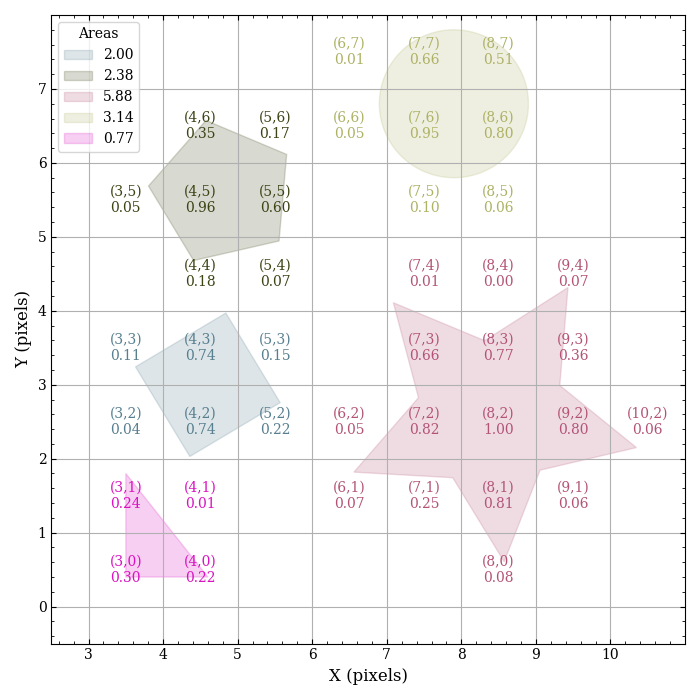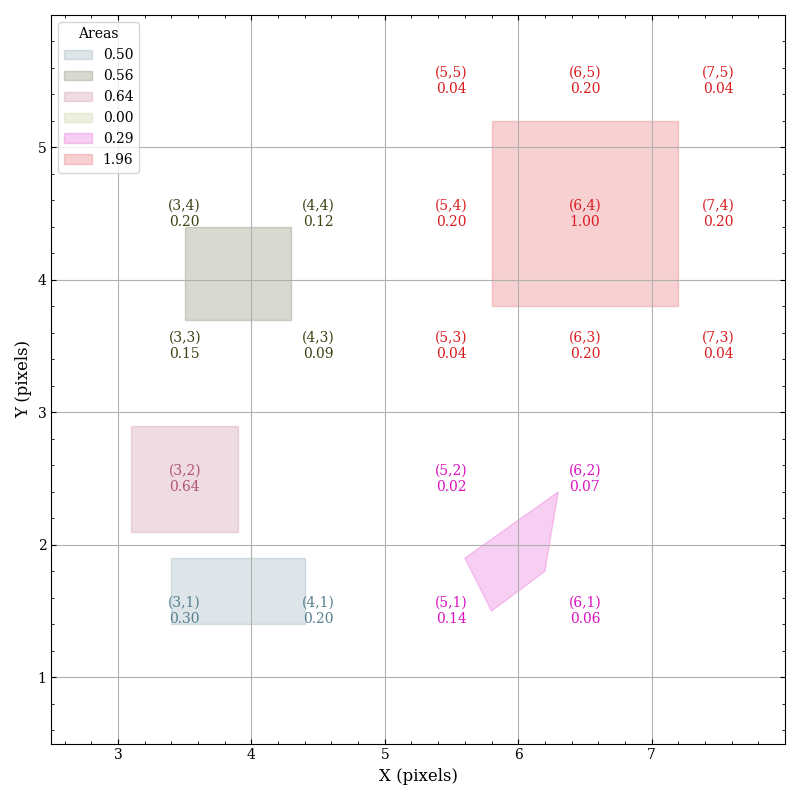A python driver for polyclip written in C by JD Smith.
linux> pip install .
The polyclip code employs the
Sutherland-Hodgman algorithm
to clip simple polygons against a tessalated grid of square pixels. Therefore, this differs from similar packages, which often clip between two arbitrary polygons. The testing function test/test_pypolyclip.py can be envoked to produce the following example figures:


The first figure shows clipping of polygons with differing numbers of vertices. Programmatically, this requires explicit for-loops in Python, but if the number of vertices is the same for all polygons (such as the second figure), the numpy can be used to improve performance by several percent. In each figure, the Cartesian coordinates for each pixel that overlaps with a given polygon are labeled with the area of that pixel that is covered (recalling the area of a pixel is defined as 1). Therefore, the sum of the areas of the individual pixels for each polygon should be the area of the polygon.
This first example demonstates polygons with the same number of vertices:
# import relevant modules
import pypolyclip
import numpy as np
# define the size of the pixel grid
naxis = (100, 100)
# create 3 polygons to clip
# the x-vertices of the polygon
px = np.array([[3.4, 3.4, 4.4, 4.4],
[3.5, 3.5, 4.3, 4.3],
[3.1, 3.1, 3.9, 3.9]], dtype=float)
# the y-vertices of the polygon
py = np.array([[1.4, 1.9, 1.9, 1.4],
[3.7, 4.4, 4.4, 3.7],
[2.1, 2.9, 2.9, 2.1]], dtype=float)
# call the clipper
xc, yc, area, slices = pypolyclip.multi(px, py, naxis)
# xc,yc are the coordinates in the grid
# area is the relative pixel area in that grid cell
# slices is a list of slice objects to link between the polygons and clipped pixel grid
# use these things like
for i, s in enumerate(slices):
print(f'total area for polygon {i}={np.sum(areas[s])}')
This second example demonstates polygons with the different number of vertices (notice the difference is in the datatype of the px and py variables):
# import relevant modules
import pypolyclip
import numpy as np
# define the size of the pixel grid
naxis = (100, 100)
# create 3 polygons to clip
# the x-vertices of the polygon
px = [[3.4, 3.4, 4.4, 4.8, 4.4],
[3.5, 3.5, 4.3, 4.3],
[3.1, 3.8, 3.1]]
# the y-vertices of the polygon
py = [[1.4, 1.9, 1.9, 1.65, 1.4],
[3.7, 4.4, 4.4, 3.7],
[2.1, 2.1, 3.4]]
# call the clipper
xc, yc, area, slices = pypolyclip.multi(px, py, naxis)
# xc,yc are the coordinates in the grid
# area is the relative pixel area in that grid cell
# slices is a list of slice objects to link between the polygons and clipped pixel grid
# use these things like
for i, s in enumerate(slices):
print(f'total area for polygon {i}={np.sum(areas[s])}')
But see also the test/test_pypolyclip.py for examples.